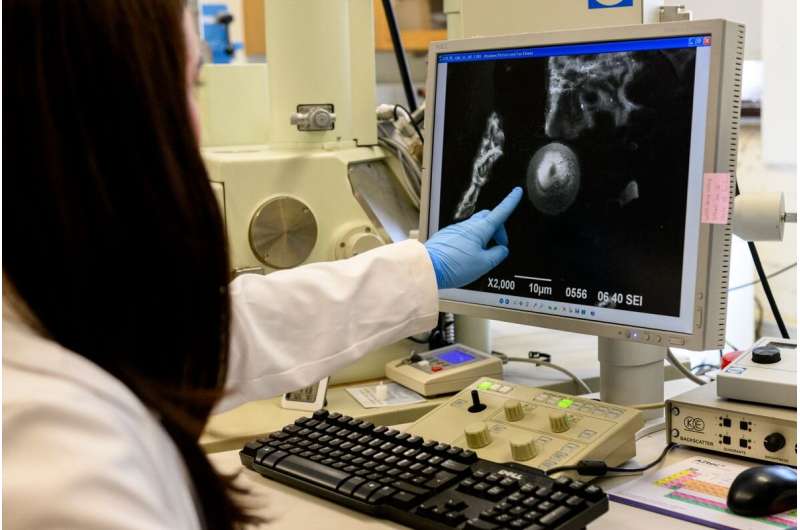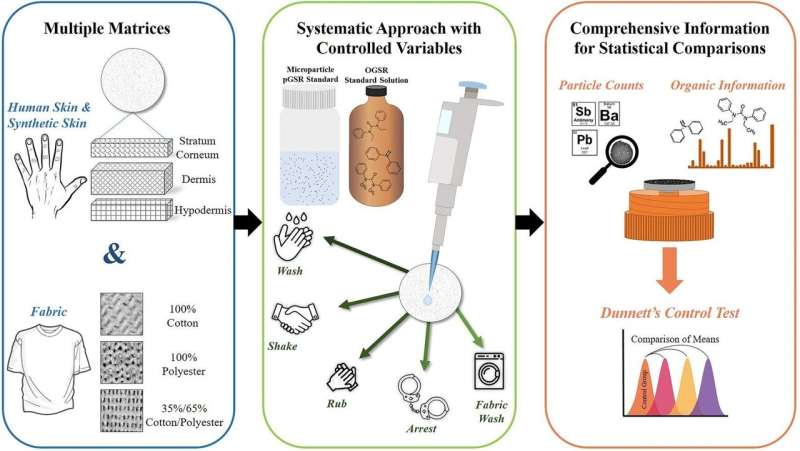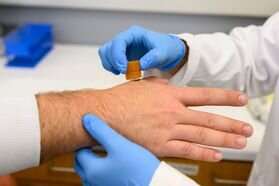This article has been reviewed according to Science X's editorial process and policies. Editors have highlighted the following attributes while ensuring the content's credibility:
fact-checked
trusted source
proofread
Forensics lab cracks case on newer, 'greener' gunshot residue

Discoveries by West Virginia University forensic scientists about how gunshot residue behaves on skin, hair and fabric will allow crime scene investigators to catch up to the proliferation of new, eco-friendly types of ammunition and make faster, more informed decisions at crime scenes and in forensic laboratories.
Lead and other toxic components of ammunition are crucial in establishing the presence of gunshot residue, or GSR, at crime scenes. However, heavy metals like lead aren't present in new "green" ammunitions that are changing the rules for GSR analysis, according to Tatiana Trejos, associate professor in the Eberly College of Arts and Sciences Department of Forensic and Investigative Science.
"A major forensics discovery was that, when you fire a gun, a cloud of particles is produced by the primer, the material that explodes and causes a bullet to eject. The primer contains, among other things, inorganic compounds, heavy metals like lead, barium, antimony," Trejos said.
"When this cloud touches our skin, tiny particles remain there. The composition of those particles is specific to firearm discharge—we don't commonly find that combination of metals in other conditions. That realization was a big help to forensic scientists in firearms-related investigations."
But over the years, ammunition has changed. More primers are manufactured without metals harmful to the environment and human health. That's a challenge for GSR analysis and the reason forensic science—a field that uses scientific methods to help solve crimes and examine trial evidence—is looking beyond inorganic compounds like metals to organic compounds like nitroglycerine that are also released when a gun fires.

"If we combine information about organic and inorganic compounds in GSR, we can have more confidence in our results," Luis Arroyo, an analytical chemist and associate professor, said. "For over a decade, scientific groups have said we need to know more about organic gunshot residue. We're missing opportunities to confirm the presence of GSR, and this research is helping to narrow that gap."
The research establishes how organic and inorganic compounds in GSR differ in the ways they each persist on surfaces and transfer to other surfaces during activities like running, hand shaking or washing.
Trejos and Arroyo published the results of the studies in a Forensic Chemistry paper co-authored with WVU graduate students Courtney Vander Pyl, Kourtney Dalzell, Korina Menking-Hoggatt and Thomas Ledergerber.
To gather data, the team created new and improved organic and inorganic GSR "reference standards" or methodologies for creating standardized mixes of particles that accurately mirror real-world gunshot residue, allowing different labs to meaningfully compare results.
They applied those particles to fabrics, to the skin and hair of real human volunteers and to an artificial skin product called Strat-M. Then they subjected those surfaces to real and simulated activities like running, struggling, washing and rubbing, before measuring the remaining particles.

Trejos said the experiments established Strat-M as a viable substitute for human skin.
"Artificial skin has been used by fields like pharmaceuticals, cosmetics, health sciences. Now we have proved it can provide a consistent forensic standard while allowing us to test conditions that wouldn't be feasible or safe for a person's skin."
The researchers found inorganic GSR particles persist longer on a surface—a palm, a sweatshirt—than organic compounds, but they're more susceptible to being lost or transferred by common activities. A shooter who washes their hands with soap and water, then dries them with a paper towel, will likely prevent crime scene investigators from identifying GSR based on analysis of lead, barium and antimony particles on their hands.
The fact that inorganic particles persist over time and are significantly lost only due to outside forces can be critical to questions about whether someone is the victim of a suicide or homicide, Trejos said.
Organic compounds, conversely, may be lost from clothing if a suspect struggles during arrest, but they are less likely to transfer to someone else, like the arresting officer.

Up to 100 characteristic inorganic particles could transfer from one person to another during a handshake, compared to no transfer at all for organic compounds. But unlike inorganic particles, organic particles are lost over time due to factors like evaporation from the skin.
Trejos said the next step is to put the findings to use in combination with another methodology the group recently developed, which allows field CSIs to immediately analyze possible GSR at a crime scene.
As enthusiastic as Trejos is about the research, she emphasizes that real-life CSIs don't have as many answers as the ones on television.
"Right now, we can do a pretty good job answering the question, 'Is GSR present or not?' But the next and more interesting question is, 'Did this person fire the gun?' Forensics is not always able to answer that with high certainty. This research opens new avenues to answer questions relevant to a judge or jury."
"By providing faster and more informative investigative tools, we're helping to apprehend offenders with more solid evidence, and we're minimizing the potential for false incarcerations."
More information: Courtney Vander Pyl et al, Transfer and persistence studies of inorganic and organic gunshot residues using synthetic skin membranes, Forensic Chemistry (2023). DOI: 10.1016/j.forc.2023.100498
Provided by West Virginia University





















